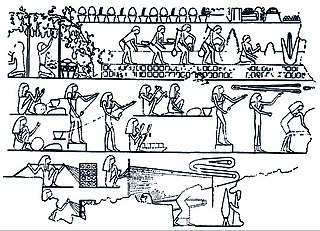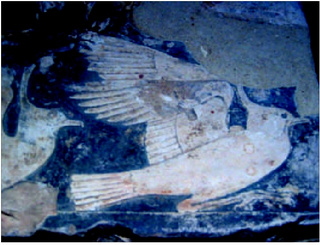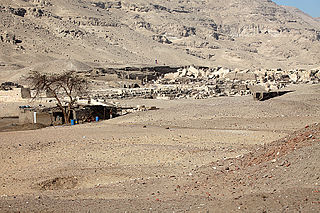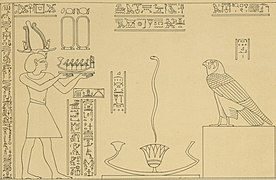
An out-of-place artifact is an artifact of historical, archaeological, or paleontological interest to someone that is claimed to have been found in an unusual context, which someone claims to challenge conventional historical chronology by its presence in that context. Some people might think that those artifacts are too advanced for the technology known to have existed at the time, or that human presence existed at a time before humans are known to have existed. Other people might hypothesize about a contact between different cultures that is hard to account for with conventional historical understanding.

Sahure was a pharaoh of ancient Egypt and the second ruler of the Fifth Dynasty. He reigned for about 13 years in the early 25th century BC during the Old Kingdom Period. Sahure's reign marks the political and cultural high point of the Fifth Dynasty. He was probably the son of his predecessor Userkaf with Queen Neferhetepes II, and was in turn succeeded by his son Neferirkare Kakai.

Pepi I Meryre was an ancient Egyptian pharaoh, third king of the Sixth Dynasty of Egypt, who ruled for over 40 years at the turn of the 24th and 23rd centuries BC, toward the end of the Old Kingdom period. He was the son of Teti, the founder of the dynasty, and ascended the throne only after the brief intervening reign of the shadowy Userkare. His mother was Iput, who may have been a daughter of Unas, the final ruler of the preceding Fifth Dynasty. Pepi I, who had at least six consorts, was succeeded by his son Merenre Nemtyemsaf I, with whom he may have shared power in a coregency at the very end of his reign. Pepi II Neferkare, who might also have been Pepi I's son, succeeded Merenre.

Mentuhotep II, also known under his prenomen Nebhepetre, was an ancient Egyptian pharaoh, the sixth ruler of the Eleventh Dynasty. He is credited with reuniting Egypt, thus ending the turbulent First Intermediate Period and becoming the first pharaoh of the Middle Kingdom. He reigned for 51 years, according to the Turin King List. Mentuhotep II succeeded his father Intef III on the throne and was in turn succeeded by his son Mentuhotep III.

Ancient Egyptian art refers to art produced in ancient Egypt between the 6th millennium BC and the 4th century AD, spanning from Prehistoric Egypt until the Christianization of Roman Egypt. It includes paintings, sculptures, drawings on papyrus, faience, jewelry, ivories, architecture, and other art media. It was a conservative tradition whose style changed very little over time. Much of the surviving examples comes from tombs and monuments, giving insight into the ancient Egyptian afterlife beliefs.

Esna is a city of Egypt. It is located on the west bank of the Nile some 55 km (34 mi) south of Luxor. The city was formerly part of the modern Qena Governorate, but as of 9 December 2009, it was incorporated into the new Luxor Governorate.

The Dendera Temple complex is located about 2.5 kilometres (1.6 mi) south-east of Dendera, Egypt. It is one of the best-preserved temple complexes of ancient Egypt. The area was used as the sixth nome of Upper Egypt, south of Abydos.

The winged sun is a solar symbol associated with divinity, royalty, and power in the Ancient Near East.

Ancient Egyptian technology describes devices and technologies invented or used in Ancient Egypt. The Egyptians invented and used many simple machines, such as the ramp and the lever, to aid construction processes. They used rope trusses to stiffen the beam of ships. Egyptian paper, made from papyrus, and pottery were mass-produced and exported throughout the Mediterranean Basin. The wheel was used for a number of purposes, but chariots only came into use after the Second Intermediate Period. The Egyptians also played an important role in developing Mediterranean maritime technology including ships and lighthouses.

The Temple of Edfu is an Egyptian temple located on the west bank of the Nile in Edfu, Upper Egypt. The city was known in the Hellenistic period in Koinē Greek: Ἀπόλλωνος πόλις and in Latin as Apollonopolis Magna, after the chief god Horus, who was identified as Apollo under the interpretatio graeca. It is one of the best preserved shrines in Egypt. The temple was built in the Ptolemaic Kingdom between 237 and 57 BC. The inscriptions on its walls provide important information on language, myth and religion during the Hellenistic period in Egypt. In particular, the Temple's inscribed building texts "provide details [both] of its construction, and also preserve information about the mythical interpretation of this and all other temples as the Island of Creation." There are also "important scenes and inscriptions of the Sacred Drama which related the age-old conflict between Horus and Seth." They are translated by the Edfu-Project.

The mortuary temple of Hatshepsut is a mortuary temple built during the reign of Pharaoh Hatshepsut of the Eighteenth Dynasty of Egypt. Located opposite the city of Luxor, it is considered to be a masterpiece of ancient architecture. Its three massive terraces rise above the desert floor and into the cliffs of Deir el-Bahari. Her tomb, KV20, lies inside the same massif capped by El Qurn, a pyramid for her mortuary complex. At the edge of the desert, 1 km (0.62 mi) east, connected to the complex by a causeway lies the accompanying valley temple. Across the river Nile, the whole structure points towards the monumental Eighth Pylon, Hatshepsut's most recognizable addition to the Temple of Karnak and the site from which the procession of the Beautiful Festival of the Valley departed. The temple's twin functions are identified by its axes: its main east-west axis served to receive the barque of Amun-Re at the climax of the festival, while its north-south axis represented the life cycle of the pharaoh from coronation to rebirth.

The sculptured Dendera zodiac is a widely known Egyptian bas-relief from the ceiling of the pronaos of a chapel dedicated to Osiris in the Hathor temple at Dendera, containing images of Taurus and Libra. This chapel was begun in the late Ptolemaic period; its pronaos was added by the emperor Tiberius. This led Jean-François Champollion to date the relief to the Greco-Roman period, but most of his contemporaries believed it to be of the New Kingdom.
Hermann Junker was a German archaeologist best known for his discovery of the Merimde-Benisalam site in the West Nile Delta in Lower Egypt in 1928.

Campana reliefs are Ancient Roman terracotta reliefs made from the middle of the first century BC until the first half of the second century AD. They are named after the Italian collector Giampietro Campana, who first published these reliefs (1842).

The word Rekhyt, also romanized as Rechit, referred to a people living in the northern Nile Delta in the Early Dynastic Period of Ancient Egypt, as well as the deity Rekhyt from the Middle Kingdom onwards. The Rekhyt people’s origins are unclear, as they were not yet considered Egyptians at the beginning of the 3rd millennium BC. Their settlement area extended to the border of Retjenu. Early inscriptions and monuments speak of the Rekhyt as mythological inhabitants of the Nile Delta, as all "northern enemies of Upper Egypt" were also among the "inhabitants of Qebehu".
Mamdouh Mohamed Gad Eldamaty is an Egyptian Egyptologist who has served in the government of Egypt as Minister of Antiquities from 2014 until 2016. He has also worked as Professor of Egyptology at the Department of Archaeology, Faculty of Arts, Ain Shams University in Cairo. On 15 May 2011, he became Cultural Counselor and Head of the Educational Mission at the Embassy of Egypt in Berlin. On 16 June 2014, it was announced that he was to be appointed as Minister of Antiquities, a position he held until March 2016 when he was replaced by Khaled al-Anani after a cabinet reshuffle.

The Department of Egyptian Antiquities of the Louvre is a department of the Louvre that is responsible for artifacts from the Nile civilizations which date from 4,000 BC to the 4th century. The collection, comprising over 50,000 pieces, is among the world's largest, overviews Egyptian life spanning Ancient Egypt, the Middle Kingdom, the New Kingdom, Coptic art, and the Roman, Ptolemaic, and Byzantine periods.
A colonnette is a small slender column, usually decorative, which supports a beam or lintel. Colonettes have also been used to refer to a feature of furnishings such as a dressing table and case clock, and even studied by archeologists in Roman ceramics. Architectural colonnettes are typically found in "a group in a parapet, balustrade, or cluster pier". The term columnette has also been used to refer to thin columns. In Khmer art, the colonnette designates in particular the columns which frame the doors of the sanctuaries and which are one of the dating elements of their style. Summits of complexity were attained in the development of the Khmer colonnette, according to Philippe Stern:
There a few designs which present, as well as the khmer colonnette, a continuity of evolution, the persistence of a direction, which, though it may weaken at times, is taken up again each time.

The Athribis Project is an archaeological and philological endeavour investigating the ruins of the Pharaonic and later Coptic Christian community of the Ancient Egyptian town of Athribis, near to the modern city of Sohag, Egypt. The aim of the project is to fully and thoroughly research, preserve and publish the written records, material technologies and phases of construction of the large temple in the town, which was dedicated to the god Min-Re, his wife Repyt and their son, the child-god Kolanthes.

Meni, Meny or Menankhpepy was an ancient Egyptian high official who lived during the reigns of Pepy I and Merenre Nemtyemsaf I, in the late Sixth Dynasty. Most of what is known about his life comes from his mastaba burial tomb in the Dendera Necropolis, a few hundred metres south of the Temple to Hathor. This tomb was explored during 1897 and 1898 by a team led by the British archaeologist Flinders Petrie.



























